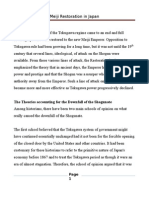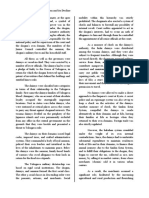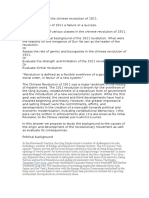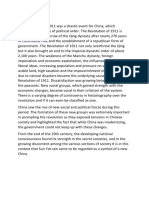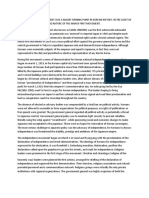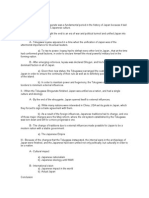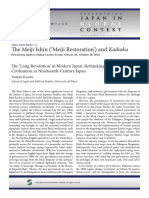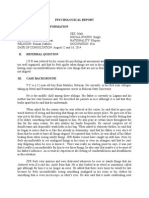Meiji Restoration PDF
Meiji Restoration PDF
Uploaded by
Saubhik MishraCopyright:
Available Formats
Meiji Restoration PDF
Meiji Restoration PDF
Uploaded by
Saubhik MishraOriginal Title
Copyright
Available Formats
Share this document
Did you find this document useful?
Is this content inappropriate?
Copyright:
Available Formats
Meiji Restoration PDF
Meiji Restoration PDF
Uploaded by
Saubhik MishraCopyright:
Available Formats
THE MEIJI RESTORATION
INTRODUCTION –
• The term ‘Meiji Restoration’ refers to the nominal restitution of the powers of the
Japanese emperor in the 1860s.
• The Meiji Restoration, occurred on 3rd January, 1868 as Emperor Meiji was restored
to the throne by the insurgent Samurai of the Tozama feudal domains of Satsuma,
Choshu, Tosa and Hizen, who spearheaded the overthrow of the Tokugawa
Shogunate(military government ) which had ruled Japan for 2.5 centuries.
BACKGROUND –
• The Meiji period was preceded by the feudal rule of the Tokugawa Shogunate, which
had come to power in 1603. Power in this period was wielded by the dynastic
military leader or shogun (bakufu) who commanded the military and political support
of the various hierarchically subordinate feudal lords. While the institution of the
Emperor was an ancient one, he was a mere figurehead.
• The effective seat of power in Japan was in Edo, at the residence of the Shogun while
the city of Kyoto, the capital of the Emperor had a largely ceremonial purpose. The
Tokugawa Shogunate operated through an elaborate administrative apparatus called
the bakufan system. The control of the Tokugawa Shogunate began to deteriorate
towards the middle of the 19th century and the meek submission of the bakufu to the
slightest threat of military force from the West and the unwillingness of the
Shogunate to consult the other daimyo of Japan coupled with the disregard for the
opinion of the Emperor resulted in a backlash against the Tokugawa Shogunate.
• The process of Restoration was a lengthy process which unfolded over a period of
time. The immediate background to the downfall of the Tokugawa Bakuhan was the
Satsuma-Choshu alliance (1866) and the military defeat at the hands of the daimyos
from the Choshu domain. Led by the militarily powerful ‘outer daimyo’ domain lords
of Satsuma, Choshu, Hizen and Tosa the discontent daimyo of Japan rebelled against
the Shogunate, overthrowing the Shogun and in 1868 proclaimed the assumption of
power by the Emperor Mutsuhito who took on the title ‘Meiji’ or the Enlightened
One and inaugurated the Meiji era (1868-1912). This was the commencement of the
Meiji Restoration.
MEIJI RESTORATION:
• Though the insurgents intended to restore imperial rule, Hugh Borton points
out that initially there was only a shift in loyalties of the feudal lords from the
bakufu to the emperor. The essential control over taxation, title to the land and
The Meiji Restoration 1
military power still remaining in the hands of approximately 267 daimyo or feudal
lords. It was expected that the institution of the Shogunate would continue despite
the restoration and that the daimyo of Satsuma, Choshu, Tosa and Hizen would
control the institution.
• However the daimyo resolved to abolish the Shogunate altogether, laying the
foundation for a new political system. As Hugh Borton points out, it was only after
the new regime addressed the economic problems that the political problems were
paid attention to. A series of measures were initiated, which included namely- land
tax reforms, abolition of feudal domains, creating self-sufficiency for food, creation of
a much needed labour force and measures for agricultural improvement.
• An entry point to the discussion of the Meiji Restoration can begin with the mention
of the Charter Oath. In the early months of 1868 the new leaders proclaimed the
Charter Oath which broadly established the principle of wide consultation before
taking decisions and spelt the end of the old exclusiveness of the bakufu system. This
was intended to secure the support of the other daimyo as well as that of the old
officials of the Tokugawa order whose administrative expertise was of vital
importance in establishing the new order.
• This enshrined the intention of the new regime to establish deliberative assemblies-
a platform for public discussions. A Diet (bicameral legislature) was created in 1889
and it had two Houses- the House of Peers, whose members were generally form
the imperial family and the other elite; and the popularly elected House of
Representatives. The latter was kept in check by the former. However, the House
of Representatives had a very important power-it could reject the budget prepared
by the cabinet if it wanted to.
• J. W. Hall highlights that the two most outstanding features of the entire
Restoration period were the overwhelming sense of foreign threat and the
leadership taken up by the samurai class. It is interesting to note that the term
‘restoration’ and not ‘revolution’ has been used to describe this sequence of crucial
events in the Japanese history. According to Hall, in comparison to the other
European Revolutions, Japan’s ‘restoration’ was quite different. There was a near
absence of social antagonism or political ideologies which had fuelled the French and
Russian revolutions. There were no mobs in the streets and even though there were
some peasant uprisings, they remained largely local and non-political.
NATURE OF THE MEIJI RESTORATION –
• The debate about the nature of the Meiji Restoration is hinged upon the
following issues. Firstly, one has to determine as to who were the participants in
this restoration process and examine the reaction of various classes- the peasants,
samurai, the daimyos etc.; and secondly, it is important to find out whether the
restoration was anti-feudal in character.
The Meiji Restoration 2
• Contemporary writers like Fukazawa Vukichi (1875) justified the Restoration.
There was a need felt to place Japan’s experience in a larger worldly context.
A group of Japanese historians called the Min’yusha’ Historians hold the opinion
that the restoration was required to get completely rid of the problems faced by the
Japanese society. These historians tend to equate the event of Restoration with the
English and the French Revolution.
PARTICIPANTS IN THE RESTORATION –
• Most of the Japanese historians glorify the role of the bourgeoisie, and especially
the smaller rural merchants in the Restoration. They assert that the driving force
came from the class of the non-samurais. It is interesting to note that while power
had been seized by the domain lords, effective power under the new order came to be
devolved upon a new class of lower to middle ranking samurai: men who had learnt
to manipulate their own feudal lords and gradually, the Emperor and his courtiers.
By the end of the 1860s, the ‘Meiji oligarchy’ had come into existence consisting of a
small group of talented administrative officials and courtiers drawn from the chief
domains. This theory was elaborated upon by a western scholar Hugh Borton.
• E. H. Norman opines that over time, the daimyos became very close to the chonin
or the merchant class. A daimyo-chonin alliance that was typically anti-bakuhan in
nature had come into being. This alliance had furthered the process of the decline of
the Shogunate and led to the Meiji restoration.
• However, some Japanese scholars such as Toyama Shigeki believe that it was the
peasants who merit attention since they were the ones who led mass uprisings.
Farmers were no longer docile and massive but were gradually becoming politically
aware about their rights. J. White and some other western historians seem to
disagree with this Shigeki’s position and instead argue that there was no link
between the peasant uprisings in the countryside and the restoration. The uprisings
and food grain riots that took place in 1866 were isolated events. They also assert
that largely speaking, in spite of these uprisings, there was stability in the villages
after all.
• Stephen Vlastos strikes the balance between these two opposing arguments. He
points out that the major uprisings that had occurred in the years between 1866-69
took place in areas where the Bakufu had a stronghold. Thus, he proposes that even
though these uprisings may not have had a direct impact as such, they certainly
hastened the entire process of the overthrow of the Tokugawa regime.
• In Marxist understanding, the Meiji Restoration can be viewed as a bourgeois
revolution. Craig and Jansen, while critiquing this view argue that the middle
class and the lower samurai hadn’t really formed a class alliance since the entire
lower samurai class didn’t participate. The lower samurai class were not aiming at
representing their own class. They had vested interest and wanted to escape the
The Meiji Restoration 3
miseries of their condition and therefore took part in the restoration. They highlight
the ‘quick silver’ role of the individuals who were constantly shifting their loyalty.
• While Craig and Jansen attribute the participation of the lower samurais to purely
economic reasons, J.W. Hall believes that there were political reasons as well.
According to Hall, they were committed to bring about a change and wanted the
Tokugawa government to take stronger steps against foreign encroachment. And as
opposed to the Marxist interpretation, Hall states that the Meiji Restoration was
neither a bourgeois nor a peasant revolution.
ANTI FEUDAL CHARACTER OF THE RESTORATION
• By 1868, top leaders of the new provisional government decided that the politically
fragmented system of domains had to be overhauled. The objective was to set up a
centralized state structure geared towards modernizing Japan in an effective
manner.
• The daimyos were asked to give up their titles and domains. Approximately 250
domains were abolished and around 72 new administrative units called ‘prefectures’
(ken) were established in their place. These prefectures were to be governed by the
state-appointed governers , who were generally the relatives of samurai leaders from
anti-tokugawa tozama areas (Choshu, Satsuma, Tosa and Hizen). Hall suggests
that the feudal lords were made to surrender using two strategies, namely pressure
and inducement. The fragmented feudal armies were replaced by one single imperial
army. Even the privileges of the elites had been reduced to the minimum.
• The samurais also lost their former prestige. They were compensated with annual
stipends. This was done in a gradual process. Keeping with the abolition of
feudalism, in 1869 the government reduced the numerous samurai ranks to two –
upper samurai (shizoku) and lower samurai or sotsu. In 1872 majority of lower
samurai were reclassified as commoners or heimin, still receiving their stipends.
In the next year, the state began taxing the stipends of the samurais. The samurais
had the choice of converting their stipends into bonds.
• By 1876, it was declared that all the stipends would be converted into bonds. As a
class, they were being eliminated and were absorbed in the society as mere
commoners. Andrew Gordon has seen this development in a positive light and
states that these measures had led to the social liberation of the samurai. This was so
because they now had the choice to opt for other occupations.
• However, if one takes a closer look, there were certain features that reinforced the
elements of feudalism. To begin with, most of these newly appointed governors
were in fact the former daimyos. As remuneration, the daimyos were given an
annual pension which was 10% of the land revenue they had been accruing earlier
when they controlled the domains earlier. They were also relieved from their duties
The Meiji Restoration 4
and responsibilities. It was a favourable situation for the daimyos and therefore they
did not resist these measures. And even the samurais were given stipends in lieu of
the privileges they once enjoyed.
• Moreover, even though the Diet was established and the constitution facilitated the
formation of deliberative assemblies, it is important to note that the House of
Representatives, which was popularly elected did not really possess powers.
• It was the House of Peers, whose members were generally chosen from the elite
classes and feudal barons, which wielded the real power. N. Peffer brings to our
notice that there were continuities that can be traced from the pre-Meiji era. By this
he implies that even though the new constitution had the nuances of a modern state,
namely a Diet, posts like that of Prime Minister etc, the oligarchic nature of the
regime wasn’t shrugged off completely.
In this way the central government in the space of about 4 years acquired control over
jurisdiction over the entire population, together with control of all the former revenues of
the domains, dissolving a system that was over 260 years old and laying the basic
requirements for the creation of a modern state. The Meiji Restoration marked a final break
with the ancient feudal order in Japan and marked its transformation into a modern,
industrialized society. The monopolization of power by the Meiji oligarchs also stimulated a
movement for greater democracy in the political system with the launching of the Popular
Rights movement which ultimately culminated in the proclamation of a new Meiji
Constitution.
The Meiji Restoration 5
You might also like
- Lab 9Document4 pagesLab 9Brandon Sookdeo45% (11)
- Meiji Restoration in JapanDocument21 pagesMeiji Restoration in JapanRamita Udayashankar100% (5)
- Crisis of Tokugawa Regime in JapanDocument13 pagesCrisis of Tokugawa Regime in JapanRamita Udayashankar100% (5)
- (MADHU MANGAL PAUL) Numerical Analysis For ScientiDocument666 pages(MADHU MANGAL PAUL) Numerical Analysis For Scientipratik chakraborty77% (13)
- Meiji RestorationDocument5 pagesMeiji RestorationAnamyaNo ratings yet
- History of Modern Japan and Korea AssignmentDocument6 pagesHistory of Modern Japan and Korea Assignmentzeba abbasNo ratings yet
- MeijiDocument24 pagesMeijihakuna matataNo ratings yet
- External Internal Factors Collapse of TokugawaDocument7 pagesExternal Internal Factors Collapse of TokugawaMIHIR BHATTNo ratings yet
- The Fall of Tokugawa Shogunate PDFDocument14 pagesThe Fall of Tokugawa Shogunate PDFRobin RalhanNo ratings yet
- Meiji Restoration and ReformsDocument6 pagesMeiji Restoration and ReformsRashi SinghNo ratings yet
- Meiji EconomyDocument10 pagesMeiji EconomysmrithiNo ratings yet
- Features of The Bakuhan System and Its DeclineDocument2 pagesFeatures of The Bakuhan System and Its DeclineNavisha Baid100% (1)
- Economic Modernization of Meiji JapanDocument15 pagesEconomic Modernization of Meiji JapanRamita Udayashankar100% (1)
- Meiji Constitution PDFDocument5 pagesMeiji Constitution PDFsmrithiNo ratings yet
- Popular Rights in Meiji PeriodDocument10 pagesPopular Rights in Meiji Periodzeba abbasNo ratings yet
- Assignment Homj - Decline of Tokugawa ShogunateDocument6 pagesAssignment Homj - Decline of Tokugawa ShogunateNishtha GoelNo ratings yet
- The Internal and External Factors Responsible For The Collapse of The Tokugawa ShogunateDocument4 pagesThe Internal and External Factors Responsible For The Collapse of The Tokugawa ShogunateSoumya Srijan Dasgupta96% (28)
- Popular RightsDocument11 pagesPopular RightssmrithiNo ratings yet
- First United FrontDocument12 pagesFirst United FrontRamita Udayashankar100% (2)
- Meiji Constitution: QuestionsDocument4 pagesMeiji Constitution: Questionssmrithi100% (3)
- Japanese Imperialism FinalDocument11 pagesJapanese Imperialism Finalshubham sharma100% (2)
- Barani AssignmentDocument7 pagesBarani Assignmentakku UshaaNo ratings yet
- 1911 Revolution AssignmentDocument4 pages1911 Revolution AssignmentchikNo ratings yet
- Japanese MilitarismDocument6 pagesJapanese Militarismzeba abbasNo ratings yet
- Popular Rights Movement in JapanDocument6 pagesPopular Rights Movement in JapanJikmik MoliaNo ratings yet
- Causes of 1911 Chinese RevolutionDocument2 pagesCauses of 1911 Chinese RevolutionGa Jing71% (7)
- May 4 Movement, 1919: System, and Foreign ImperialismDocument4 pagesMay 4 Movement, 1919: System, and Foreign ImperialismRiya vermaNo ratings yet
- Modern India 2Document5 pagesModern India 2Abhinav PriyamNo ratings yet
- Persian Sources For Reconstructing History of Delhi SultanateDocument6 pagesPersian Sources For Reconstructing History of Delhi SultanateKundanNo ratings yet
- Background and Causes of The Revolution of 1911Document6 pagesBackground and Causes of The Revolution of 1911Kusum KumariNo ratings yet
- Japanese ImperialismDocument15 pagesJapanese Imperialismsmrithi100% (2)
- 1911 Revolution in ChinaDocument4 pages1911 Revolution in ChinayashNo ratings yet
- US OCCUPation and How It Influenced JDocument18 pagesUS OCCUPation and How It Influenced JsmrithiNo ratings yet
- Sufis Relation With The StateDocument6 pagesSufis Relation With The StateNikita KohliNo ratings yet
- Economic Reforms - MeijiDocument7 pagesEconomic Reforms - Meijisourabh singhalNo ratings yet
- The Self Strengthening MovementDocument2 pagesThe Self Strengthening MovementRamita Udayashankar33% (3)
- Military Tactics + Gun PowderDocument6 pagesMilitary Tactics + Gun Powdermaham sanayaNo ratings yet
- VijayanagarDocument4 pagesVijayanagarpooja.r0829No ratings yet
- VijaynagarDocument15 pagesVijaynagarsmrithi100% (1)
- Japan's March Toward MilitarismDocument5 pagesJapan's March Toward MilitarismRadhar TribaskoroNo ratings yet
- Agricultural and Industrial Development in Meiji JapanDocument12 pagesAgricultural and Industrial Development in Meiji JapanSania MariamNo ratings yet
- 1911 Revo AnsDocument9 pages1911 Revo Ansvaishnavi thakurNo ratings yet
- History of India IV: Assignment: - Submitted by Sasanbha Lytan, 2 Year, B.A. History (Hons)Document8 pagesHistory of India IV: Assignment: - Submitted by Sasanbha Lytan, 2 Year, B.A. History (Hons)shabdita50% (2)
- 17th CenturyDocument8 pages17th CenturySonia Khileri100% (1)
- Final Paper: ASIA 519 History of Japanese International Relations and Foreign PolicyDocument9 pagesFinal Paper: ASIA 519 History of Japanese International Relations and Foreign PolicysmrithiNo ratings yet
- May Fourth MovementDocument5 pagesMay Fourth MovementRashi SinghNo ratings yet
- The May Fourth Intellectual Revolution, 1917-1923Document5 pagesThe May Fourth Intellectual Revolution, 1917-1923Ramita Udayashankar100% (4)
- March First MovementDocument4 pagesMarch First MovementM.K.100% (1)
- (B) Taiping and Boxer Movements - Causes, Ideology, NatureDocument7 pages(B) Taiping and Boxer Movements - Causes, Ideology, Natureinsha moquitNo ratings yet
- Unit 1-4 HisDocument246 pagesUnit 1-4 HisMahendra Pratap Singh RajawatNo ratings yet
- A Study of Sources of The Sultanate With Emphasis On The Malfuzat and The Premakhyan TraditionDocument8 pagesA Study of Sources of The Sultanate With Emphasis On The Malfuzat and The Premakhyan TraditionIt's vibpathak100% (1)
- MilitarismDocument9 pagesMilitarismAnaya Sharma100% (1)
- Seema Dass KI: 1326881 Napoleon 1Document10 pagesSeema Dass KI: 1326881 Napoleon 1Ngan Ping Ping100% (1)
- The Taiping Rebellion/Uprising in ChinaDocument5 pagesThe Taiping Rebellion/Uprising in ChinaRamita Udayashankar60% (5)
- Women SaintsDocument4 pagesWomen Saintspooja.r0829No ratings yet
- The Marathas Under The Peshwas HistoryDocument11 pagesThe Marathas Under The Peshwas HistoryShubham SrivastavaNo ratings yet
- The Internal and External Factors Responsible For The Collapse of The Tokugawa ShogunateDocument7 pagesThe Internal and External Factors Responsible For The Collapse of The Tokugawa ShogunateAnushka DattaNo ratings yet
- The Tokugawa ShogunateDocument4 pagesThe Tokugawa ShogunateJessEspinozaNo ratings yet
- BHIE-142 Solved AssignmentDocument5 pagesBHIE-142 Solved AssignmentDivyansh BajpaiNo ratings yet
- Modeern JappanDocument10 pagesModeern JappanRimpa KarmakarNo ratings yet
- The Meiji Ishin ( Meiji Restoration') and KaikokuDocument8 pagesThe Meiji Ishin ( Meiji Restoration') and KaikokuBlackstone71No ratings yet
- Tokugava SogumateDocument7 pagesTokugava SogumateRitika VermaNo ratings yet
- Semeia 65, Orality and Textuality in Early Christian LiteratureDocument228 pagesSemeia 65, Orality and Textuality in Early Christian Literaturee.masanyalazi80% (5)
- Latin MaximsDocument1 pageLatin MaximsMaria CarmelaNo ratings yet
- Fruit of The Spirit PatienceDocument3 pagesFruit of The Spirit Patiencerichard5049No ratings yet
- Juris Law Offices ProfileDocument5 pagesJuris Law Offices ProfileVikas NagwanNo ratings yet
- The Challenges of Strategic ManagmentDocument22 pagesThe Challenges of Strategic Managmentandushh20018520100% (1)
- Mi Vida y Obra de Henry Ford - Libro Electrónico GratuitoDocument5 pagesMi Vida y Obra de Henry Ford - Libro Electrónico Gratuitoamurcia14No ratings yet
- Teaching Strategies in A Multicultural Classroom: Prachi NaddaDocument4 pagesTeaching Strategies in A Multicultural Classroom: Prachi NaddaRobert SolisNo ratings yet
- Case Study For OCDDocument10 pagesCase Study For OCDrowwwlizNo ratings yet
- Lesson III: Studying Anthropology, Political Science, and SociologyDocument2 pagesLesson III: Studying Anthropology, Political Science, and Sociologyiricamae ciervoNo ratings yet
- Hints For Lovers by Haultain, ArnoldDocument106 pagesHints For Lovers by Haultain, ArnoldGutenberg.orgNo ratings yet
- Syllabus BC547 SufferingDocument7 pagesSyllabus BC547 SufferingdonjazonNo ratings yet
- Gazetas and Mylonakis 1999 PDFDocument10 pagesGazetas and Mylonakis 1999 PDFempsaroudakisNo ratings yet
- Ashtanga Yoga I and II Complete OCR (Finereader - IsTA SettingsDocument192 pagesAshtanga Yoga I and II Complete OCR (Finereader - IsTA SettingsAndreea Bertea0% (1)
- EEOMDocument15 pagesEEOMGillianne Mae VargasNo ratings yet
- Sociology PresentationDocument16 pagesSociology Presentationfahad ansariNo ratings yet
- Estudios Urbanisticos Literatura HispanoamericanaDocument223 pagesEstudios Urbanisticos Literatura HispanoamericanaCésar Andrés ParedesNo ratings yet
- ArthockneyDocument2 pagesArthockneydaveorrittNo ratings yet
- CannibalsDocument4 pagesCannibalsDallasNo ratings yet
- Lesson Nine: A. New WordsDocument15 pagesLesson Nine: A. New WordsalipooliNo ratings yet
- GR No 100150Document13 pagesGR No 100150Ranger Rodz TennysonNo ratings yet
- IronyDocument1 pageIronyDas EducationNo ratings yet
- GCSE Questions On VECTORS:, in Terms of A and BDocument7 pagesGCSE Questions On VECTORS:, in Terms of A and BSkyNo ratings yet
- Literary Techniques DevicesDocument59 pagesLiterary Techniques DevicesJhayce Christian S. CapanayanNo ratings yet
- 819 Philosophy Value NeutralityDocument32 pages819 Philosophy Value NeutralityAdom Appiah Agyekum EDZIINo ratings yet
- (PDF Download) Football and The Law Nick de Marco QC Fulll ChapterDocument34 pages(PDF Download) Football and The Law Nick de Marco QC Fulll Chapteradriluhakuma82100% (5)
- Personal EssayDocument2 pagesPersonal EssayJohn ManciaNo ratings yet

